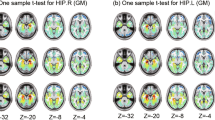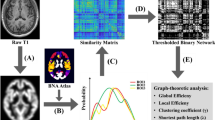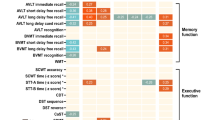Abstract
The cortical atrophy measured from the magnetic resonance imaging (MRI) data along with aberrant neuronal activation patterns from the functional MRI data have been implicated in the mild cognitive impairment (MCI), which is a potential early form of a dementia. The association between the level of cortical atrophy in the gray matter (GM) and corresponding degree of neuronal connectivity, however, has not systematically been presented. In this study, we aimed to provide anecdotal evidence that there would be a close link between the anatomical abnormality and corresponding functional aberrance associated with the neuropsychiatric condition (i.e. MCI). Firstly, the voxel-based morphometry (VBM) analysis identified the medial temporal lobe and inferior parietal lobule as the regions with substantially decreased (i.e. atrophy) and increased GM concentrations, respectively. In the subsequent functional connectivity (FC) analysis via Pearson’s correlation coefficients, the FC patterns using the regions with a decreased GM concentration showed increased FC patterns (i.e. hyper-connectivity) associated with the MCI. On the other hand, the FC patterns using the seed regions with an increased GM concentration have shown decreased FC (i.e. hypo-connectivity) with the MCI in the task anti-correlated regions including superior frontal gyrus (i.e. task-negative networks or default-mode networks). These results provide a supplemental information that there may be an compensatory mechanism in the human brain function, which potentially allow to diagnose early phase of the neuropsychiatric illnesses including the Alzheimer’s diseases (AD).
Access this chapter
Tax calculation will be finalised at checkout
Purchases are for personal use only
Preview
Unable to display preview. Download preview PDF.
Similar content being viewed by others
References
Dickerson, B.C., Sperling, R.A.: Functional Abnormalities of the Medial Temporal Lobe Memory System in Mild Cognitive Impairment and Alzheimer’s Disease: Insights from Functional MRI Studies. Neuropsychologia 46(6), 1624–1635 (2008)
Fan, Y., Resnick, S.M., Wu, X., Davatzikos, C.: Structural and Functional Biomarkers of Prodromal Alzheimer’s Disease: a High-dimensional Pattern Classification Study. Neuroimage 41(2), 277–285 (2008)
Buckner, R.L., Snyder, A.Z., Sanders, A.L., Raichle, M.E., Morris, J.C.: Functional Brain Imaging of Young, Nondemented, and Demented Older Adults. J. Cogn. Neurosci. 12(suppl.2), 24–34 (2000)
Greicius, M.D., Srivastava, G., Reiss, A.L., Menon, V.: Default-mode Network Activity Distinguishes Alzheimer’s Disease from Healthy Aging: Evidence from Functional MRI. Proc. Natl. Acad. Sci. U S A 101(13), 4637–4642 (2004)
Wang, K., Liang, M., Wang, L., Tian, L., Zhang, X., Li, K., Jiang, T.: Altered Functional Connectivity in Early Alzheimer’s Disease: a Resting-state fMRI Study. Hum. Brain Mapp. 28(10), 967–978 (2007)
Ashburner, J., Friston, K.: Voxel-based Morphometry—the Methods. Neuroimage 11, 805–821 (2000)
Mak, H.K., Zhang, Z., Yau, K.K., Zhang, L., Chan, Q., Chu, L.W.: Efficacy of Voxel-based Morphometry with DARTEL and Standard Registration as Imaging Biomarkers in Alzheimer’s Disease Patients and Cognitively Normal Older Adults at 3.0 Tesla MR Imaging. J. Alzheimers Dis. 23(4), 655–664 (2011)
Gili, T., Cercignani, M., Serra, L., Perri, R., Giove, F., Maraviglia, B., Caltagirone, C., Bozzali, M.: Regional Brain Atrophy and Functional Disconnection across Alzheimer’s Disease Evolution. J. Neurol. Neurosurg. Psychiatry 82(1), 58–66 (2011)
Huettel, S.A., Song, A.W., McCarthy, G.: Functional Magnetic Resonance Imaging, 2nd edn. Sinauer Associates, Inc., Sunderland (2009)
Rytsar, R., Fornari, E., Frackowiak, R.S., Ghika, J.A., Knyazeva, M.G.: Inhibition in Early Alzheimer’s Disease: An fMRI-based Study of Effective Connectivity. Neuroimage (2011) Epub ahead of print
Seth, A.K.: A MATLAB Toolbox for Granger Causal Connectivity Analysis. J. Neurosci. Methods 186, 262–273 (2010)
Author information
Authors and Affiliations
Editor information
Editors and Affiliations
Rights and permissions
Copyright information
© 2011 Springer-Verlag Berlin Heidelberg
About this paper
Cite this paper
Kim, J., Lee, JH. (2011). Functional Connectivity Analysis with Voxel-Based Morphometry for Diagnosis of Mild Cognitive Impairment. In: Lu, BL., Zhang, L., Kwok, J. (eds) Neural Information Processing. ICONIP 2011. Lecture Notes in Computer Science, vol 7062. Springer, Berlin, Heidelberg. https://doi.org/10.1007/978-3-642-24955-6_37
Download citation
DOI: https://doi.org/10.1007/978-3-642-24955-6_37
Publisher Name: Springer, Berlin, Heidelberg
Print ISBN: 978-3-642-24954-9
Online ISBN: 978-3-642-24955-6
eBook Packages: Computer ScienceComputer Science (R0)




